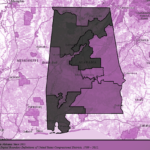This is the second article of a 10 part series on redistricting + apportionment + gerrymandering, in relation to Alabama.
The basis for all redistricting is the data from the U.S. Census. The first nation in the world to take a regular population census, the United States has been counting its population every 10 years since 1790—as required by the U.S. Constitution (Article I, Section 2). For the count, the Constitution specifies “free persons,” not citizens. (For more information on the evolution of the Census, see this article from PRB.) In the early days the only way to accomplish this was for somebody to go door-to-door. Technology has of course changed the way that the Census is conducted, from exclusively door-to-door, writing information down on the form, to online data collection. The verb that is used in the Constitution to mean “count” is “enumerate,” and to this day the people who are hired by the Census to follow up on the online-census by going door-to-door are called “enumerators.” The questions that are asked have also changed over time, and the terminology (for example, in the 1880 census the enumerator asked whether any person being counted in the household was “idiotic,” which was apparently different from “insane”). It’s quite interesting to look at earlier census data for one’s own ancestors on a genealogy website.
The complete census data is not made public until 72 years have elapsed, to protect privacy. Until that time requirement is reached, the census data released to accomplish the required redistricting does not include anything that would clearly identify individuals (obviously, for example, names and addresses). Certain demographic information, however, is important for redistricting (such as race and ethnicity). In order to protect anonymity in an age of increasing technological sophistication, the Census Bureau has been working on ways to protect privacy. The current “differential privacy” approach is controversial, but apparently relevant not for congressional-level districts, but rather at the state level. NPR has a discussion of the issue here, “For the U.S. Census, Keeping Your Data Anonymous and Useful is a Tricky Balance.” This article also includes a link to a lawsuit filed in March challenging the differential privacy approach, with U. S. Representative Aderholt of Alabama’s 4th District as the main plaintiff.
The Census Bureau reports its data to Congress, by state. If a state’s population has increased, it is possible that the state could have more representation in the House of Representatives in the form of an additional Congressional district. If a state’s population has decreased, it is possible that it could lose a seat (as people were worrying about recently for Alabama). If a state’s population has increased, it could still lose a seat because other states may have had larger increases. How the number of seats is calculated and allocated to the states is discussed in the next post (#3).
Remember that the U.S. Senate is not affected by the census data because the Constitution allocated two senators to each state no matter what the population. (Read more about the rationale for this decision on the the US Senate website.)
Once the Census data has been received by Congress, the process of determining any changes in the number of Congressional districts is called “reapportionment.” This will be discussed in the next post. Remember also that the Census data may have implications for state-level districts, because population may move around within an individual state and require redrawing of state legislative districts and other district lines as well. See post #10 for further discussion.
Here is a very helpful video from the Census Bureau that explains how the data will be presented in two formats with the intention that not only elected officials and data nerds be able to use it, but also regular citizens.
This series is a joint effort of the blog editor, Catherine Davies, and other members of the Advocacy Team and Board of the League of Women Voters of Alabama.

